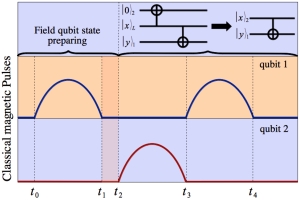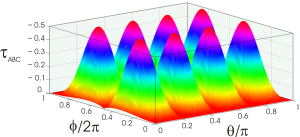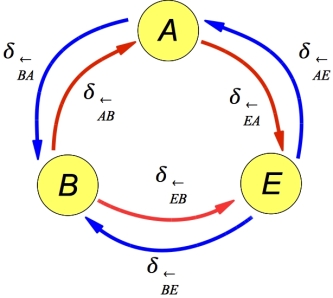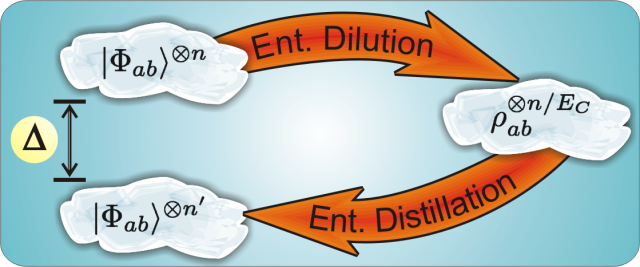 Solid state superconducting devices coupled to coplanar transmission lines offer an exquisite architecture for quantum optical phenomena probing as well as for quantum computation implementation, being the object of intense theoretical and experimental investigation lately. In appropriate conditions the transmission line radiation modes can get strongly coupled to a superconducting device with only two levels -for that reason called artificial atom or qubit. Employing this system we propose a hybrid two-quantum bit gate encoding involving quantum electromagnetic field qubit states prepared in a coplanar transmission line capacitively coupled to a single charge qubit. Since dissipative effects are more drastic in the solid state qubit than in the field one, it can be employed for storage of information, whose efficiency against the action of an ohmic bath show that this encoding can be readily implemented with present day technology. We extend the investigation to generate entanglement between several solid state qubits and the field qubit through the action of external classical magnetic pulses. See at http://xxx.lanl.gov/abs/1110.1355
Solid state superconducting devices coupled to coplanar transmission lines offer an exquisite architecture for quantum optical phenomena probing as well as for quantum computation implementation, being the object of intense theoretical and experimental investigation lately. In appropriate conditions the transmission line radiation modes can get strongly coupled to a superconducting device with only two levels -for that reason called artificial atom or qubit. Employing this system we propose a hybrid two-quantum bit gate encoding involving quantum electromagnetic field qubit states prepared in a coplanar transmission line capacitively coupled to a single charge qubit. Since dissipative effects are more drastic in the solid state qubit than in the field one, it can be employed for storage of information, whose efficiency against the action of an ohmic bath show that this encoding can be readily implemented with present day technology. We extend the investigation to generate entanglement between several solid state qubits and the field qubit through the action of external classical magnetic pulses. See at http://xxx.lanl.gov/abs/1110.1355
Oct 24
Joint field and solid-state qubits
Oct 24
Conditions for Monogamy of Entanglement of Formation
We present a set of conditions that an arbitrary pure tripartite state must satisfy in order that the Entanglement of Formation (EOF) becomes a monogamic measure. The monogamic relation derived is deeply connected to the discrepancy between classical and quantum correlations, embodying the possible negative signal of the EOF tangle whenever the quantum correlation is larger than the classical one. The estimated limits bound the possible amount of quantum conditional entropy in the system. We present general analytical results for a three- qubit system and give a simple numerical algorithm to calculate the EOF tangle for a system with dimension 2 × 2 × N. Those results are employed to elucidate features of the distribution of entanglement during a dynamical evolution. See more athttp://xxx.lanl.gov/abs/1110.1054
Oct 24
Locally Inaccessible Information and Entanglement of Formation
Quantum discord (QD) measures the fraction of the pairwise mutual information that is locally inaccessible, in a multipartite system. Fundamental aspects related to two important measures in quantum information theory the Entanglement of Formation (EOF) and the conditional entropy, can be understood in terms of the distribution of this form of Local Inaccessible Information (LII). As such, the EOF for an arbitrarily mixed bipartite system AB can be related to the gain or loss of LII due to the extra knowledge that a purifying ancillary system E has on the pair AB. Similarly, a clear meaning of the negativity of the conditional entropy for AB is given. We exemplify by showing that these relations elucidate important and yet not well understood quantum features, such as the bipartite entanglement sudden death and the distinction between EOF and QD for quantifying quantum correlation. For that we introduce the concept of LII flow which quantifies the LII shared in multipartite system when a sequential local measurements are performed. To appear in New Journal of Physics. See preprint athttp://xxx.lanl.gov/abs/1106.0289
Oct 24
Entanglement irreversibility from quantum discord and quantum deficit
We relate the problem of irreversibility of entanglement with the recently defined measures of quantum correlation – quantum discord and one-way quantum deficit. We show that the entangle- ment of formation is always strictly larger than the coherent information and the entanglement cost is also larger in most cases. We prove irreversibility of entanglement under LOCC for a family of entangled states. This family is a generalization of the maximally correlated states for which we also give an analytic expression for the distillable entanglement, the relative entropy of entanglement, the distillable secret key and the quantum discord. Phys. Rev. Lett. 107, 020502 (2011) , also in http://xxx.lanl.gov/abs/1007.0228
Oct 24
Quantum measurement and control in optomechanical systems
During the week of 9-13 of May prof. Gerard Milburn is visiting us and is delivering a series of lectures from 9 to 12 on
“Quantum measurement and control in optomechanical systems“
Prof. Gerard J. Milburn
The Univerity of Queensland, Brisbane, Australia
Director of the “Centre of Excellence in Engineered Quantum Systems”
The emerging field of quantum optomechanics combines quantum optics and new fabrication techniques to control the quantum state of macroscopic mechanical resonators. This now provides a new approach for controlling the mutual interaction between light and mesoscopic structures, which is one of the eminent goals in quantum information science and of importance for fundamental experiments at the quantum-classical boundary. I will give an overview of this new field and discuss some specific models. These include a scheme to conditionally prepare a macroscopic mechanical resonator in an energy eigenstate by measurement, single photon optomechanics, and quantum entanglement in optomechanical networks.
Date and time: 09 to 11/05/2011 at 14:00 and colloquium in 12/05/2011 at 16:00.
Place: Seminar room DFMC/IFGW/UNICAMP and colloquium hall IFGW
More information please go to the course page



